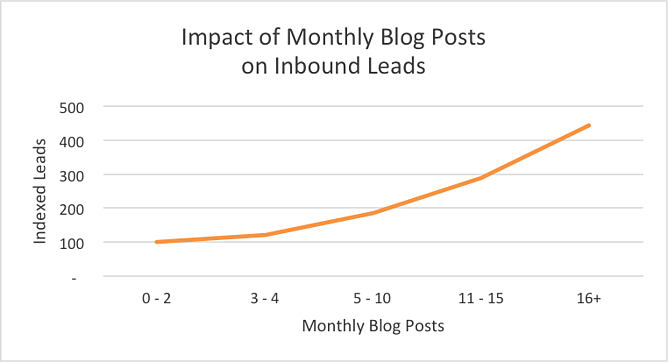Of Course Your Website Can Be Performing Better for Lead Gen
There are plenty of surface-level things to check for when you’re analyzing a website for its lead generation potential from the outside — ungated premium content, no calls-to-action in blog posts, poorly constructed landing pages and more.
But sometimes, websites seemingly do everything they’re supposed to do and they still suffer from poor lead conversion numbers, or the leads are not qualified to do business with your firm. What gives?
It may be satisfying to be able to check off all of the boxes of good lead generation design, but a good mix of gated and free content packaged up in a nice design isn’t enough to generate quality leads. After all, not all traffic or leads are created equal. With a solid inbound foundation, you’ll ensure that you’re getting quality, not just quantity.
So how do you generate quality leads from your website? To answer this question, we have to take a few steps back and start at the fundamentals of inbound marketing. Ask yourself if the content on your website aligns with these concepts.
Write to Your Buyer Personas
You might know who you want your content to reach, but writing to that audience before conducting research is a mistake. Your content needs to add value to your audience, and there is little chance of inherently knowing what’s valuable to your audience.
A buyer persona is based on market research and interviews conducted with existing customers. A detailed persona includes information like demographics, motivations, pain points and goals. These details will guide your editorial calendar and content strategy, ensuring your efforts won’t go to waste. Therefore, keeping your personas top of mind is crucial to the success of your inbound marketing strategy. In fact, we suggest printing out your persona profiles and keeping them in a visible place in your office.
Here at Austin Lawrence, we take the personas a step further with the concept of a Big Idea — a theme that unifies brand connection and customer audience.
What is your niche? What differentiates you from your competitors? By researching your audience and building rich personas, you can identify the channel missing from your market and develop it. And after doing your research, you might be surprised at the big ideas missing from your marketplace.
For example, the initial piece of Kodak’s Chief Packaging Officer’s content was a white paper drawing parallels to CIO, CFO and other recent c-suite additions. We built an entire content hub around this white paper — we recruited an industry thought leader to blog about the need for a CPO, developed content including in-depth interviews with packaging leaders at CPG firms, curated content that informed packaging leaders on trends and influences on their business and built white papers, ROI calculators and webinars gated by landing pages and forms to create leads. This fully realized content strategy, backed by the Big Idea that packaging is a strategic function worthy of a c-suite title and career path, brought in relevant traffic and offered visitors content and engagement that led to conversion.
Ask yourself: Have you done your persona research and is your content relevant to them? Is your content aligned with your personas' interests and wants? Do you have a Big Idea that drives all of your site’s content?
Do Your Keyword Research
Creating content for your personas also means using the words and phrases they search for. This way, more prospects find your website and content through search. Do the work to maximize the outcome of your content’s performance.
Keyword research tells you estimated search volume by location, how difficult it is to rank for keywords and the estimated cost of purchasing search traffic through pay-per-click advertising. Keywords with relatively high monthly search volume (at least 100 searches) and low competition level are ideal.
Use your list of keywords to plan your content.
Ask yourself: Am I optimizing my content for search by using a keyword often searched for by my persona? Does the H1 tag of my content contain one of my keywords? (SEO best practice would see this keyword in the meta description and title tags, URL and alt text in images or videos.)
Create Content That Reflects Your Personas’ Thoughts
So far, this post stresses inbound fundamentals, but there are also some copywriting strategies that persist regardless of who your persona is. One happens to be that people resonate with writing that mirrors their needs, not the needs of your company.
Imagine your business sells home decor. You plan to publish a blog post targeting your persona Deborah the Interior Designer about a new line of chandeliers you’re offering.
Contrast these two titles for the same blog post:
Announcing Our Five New Chandeliers
Even Your Pickiest Clients Will Love These Chandeliers
The first title is written from your business’s point of view, while the second one reflects the feelings and desires of your prospects. If the titles of your content shine the spotlight on your business, try to turn that light back onto the minds of your prospects.
When you’re creating your editorial calendar, review your personas and see what phrases jump out to you — the fears, aspirations and goals your personas have — and brainstorm content ideas that directly address these ideas. You can even use words straight from your persona interviews.
And this idea doesn’t end at text. Keep your personas in mind when you’re picking out images for your website, too. What would they like to see? Do the images of people on your website represent the demographics of your personas?
Ask yourself: Does the content for my personas reflect their fears, desires and goals? Or does the content only speak from my point of view?
Invest Enough Time and Money in Your Content
We’ve touched on the content quality versus quantity debate here before. While you don’t want to sacrifice quality for quantity, the truth is that you need to be publishing quality content consistently to generate a decent number of qualified leads.
HubSpot analyzed data on its customers and found that companies that published more than 16 blog posts per month got almost 3.5 times more traffic than companies that published between zero and four monthly posts.
The message is clear: the more often you publish, the more traffic your site sees. Every time you publish a new blog post, you’re creating a new opportunity to be found via search and be shared on social media.
And if your content is engaging and written to your personas, then the more qualified leads your site will generate.
Ask yourself: Can I invest more in my business’ content? What can I do to make sure I publish just one more blog post a week to start?
Even if you’ve been creating content without these strategies, it’s not too late to start a new content strategy built on the foundation of rich, well-researched personas and keywords.
Once you have your new content strategy in place, does your sales team have a plan for converting website leads into sales? Qualified inbound leads need to be followed up quickly and repeatedly to extract the most value from your content investment.
Learn how to maximize ROI from your efforts by reading our coaching guide, “Handling Inbound Leads.” Download the customizable playbook here.







